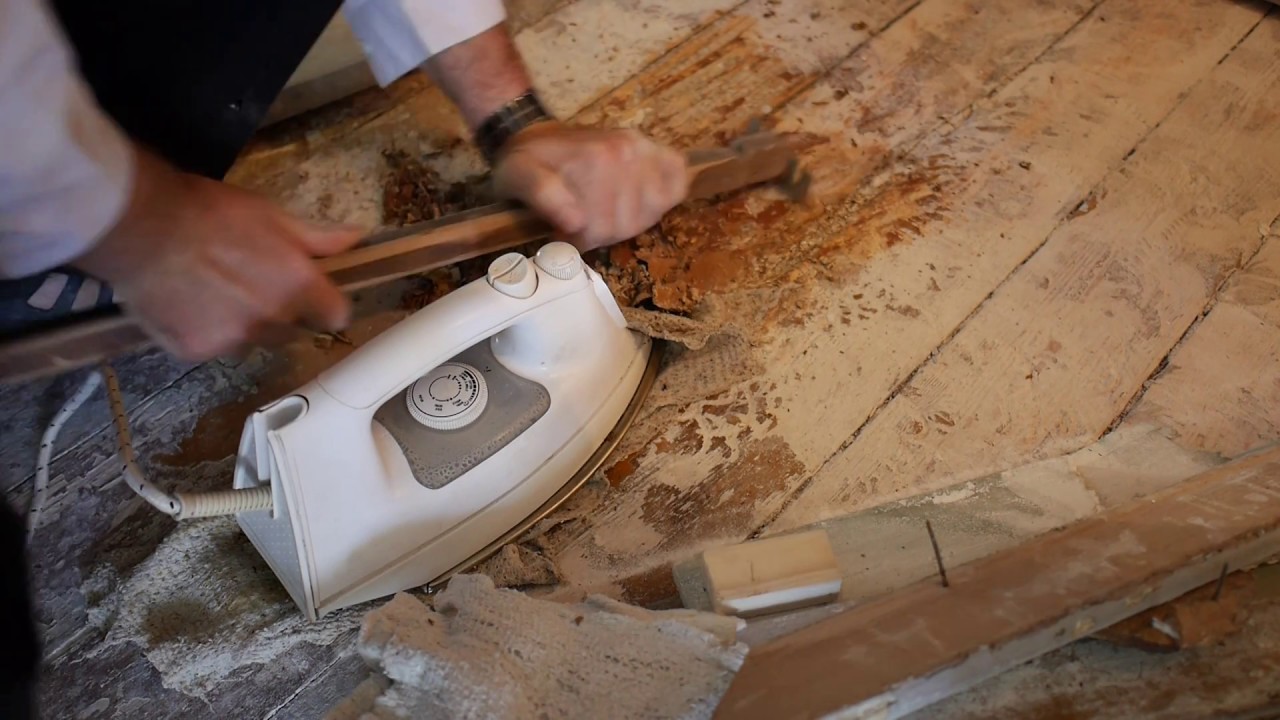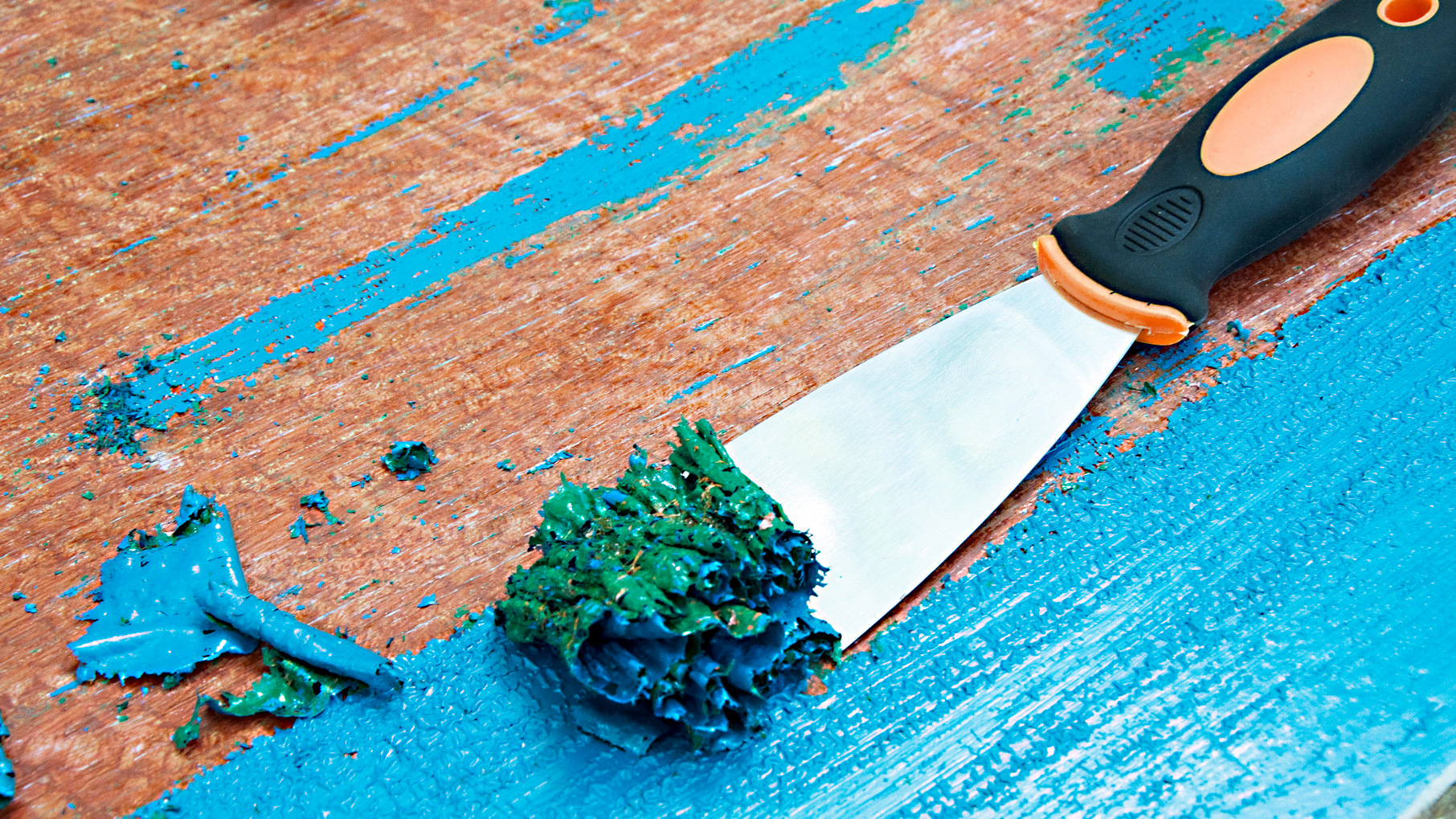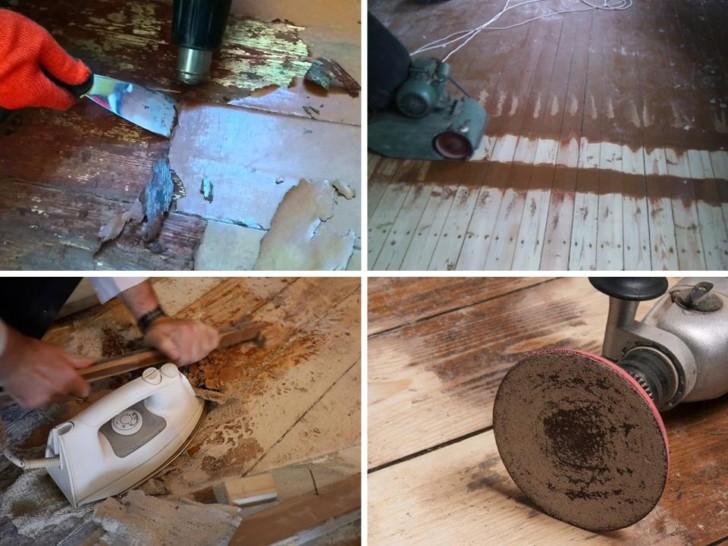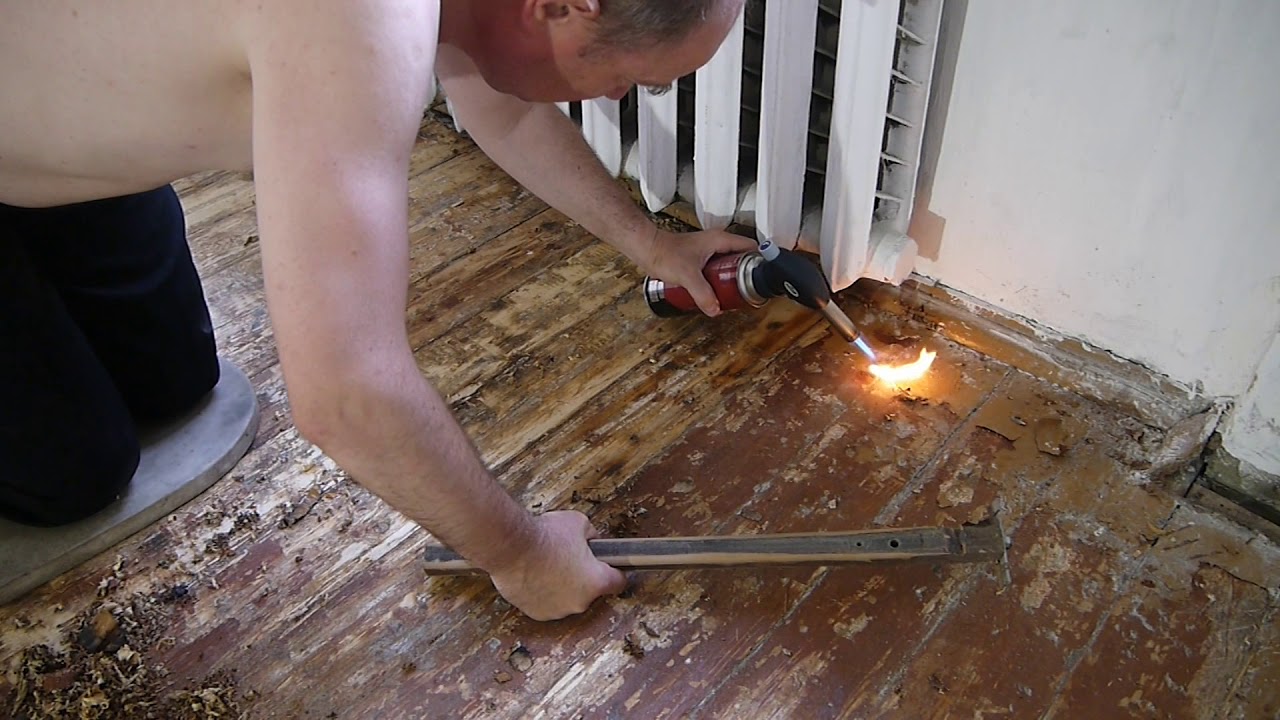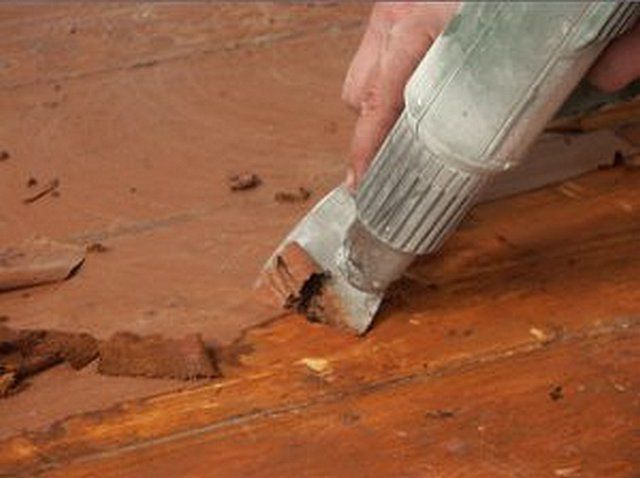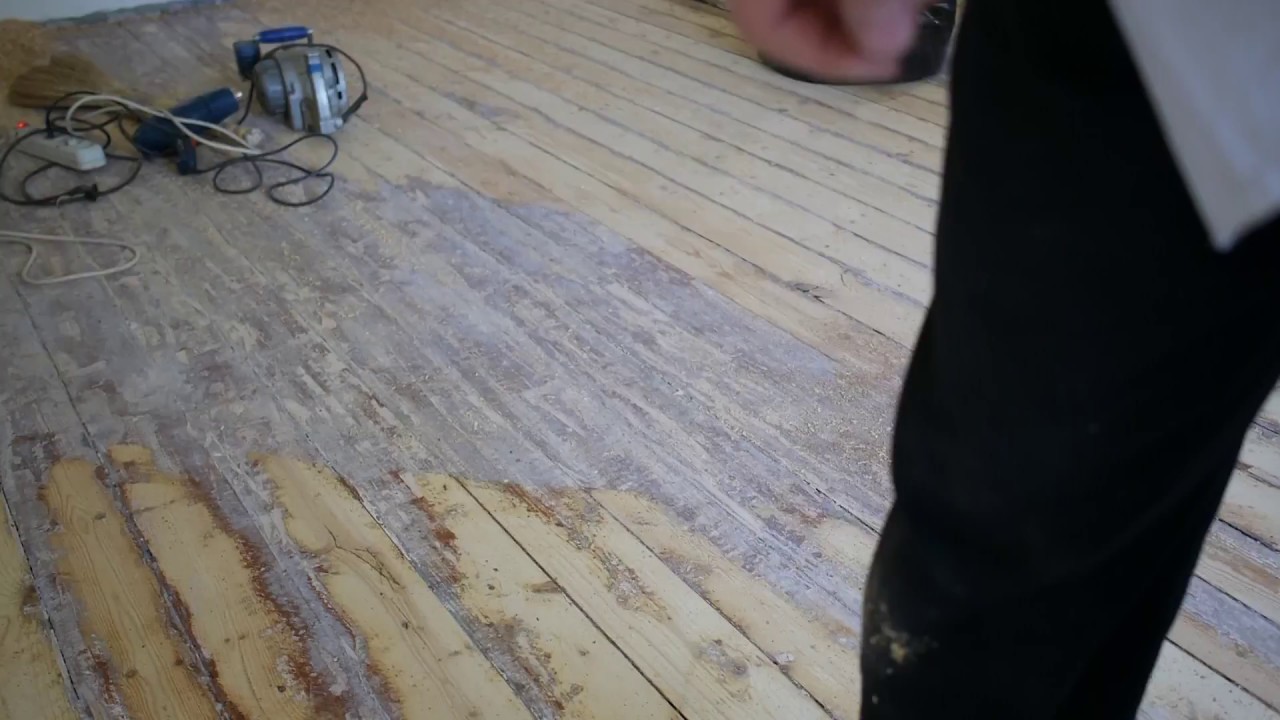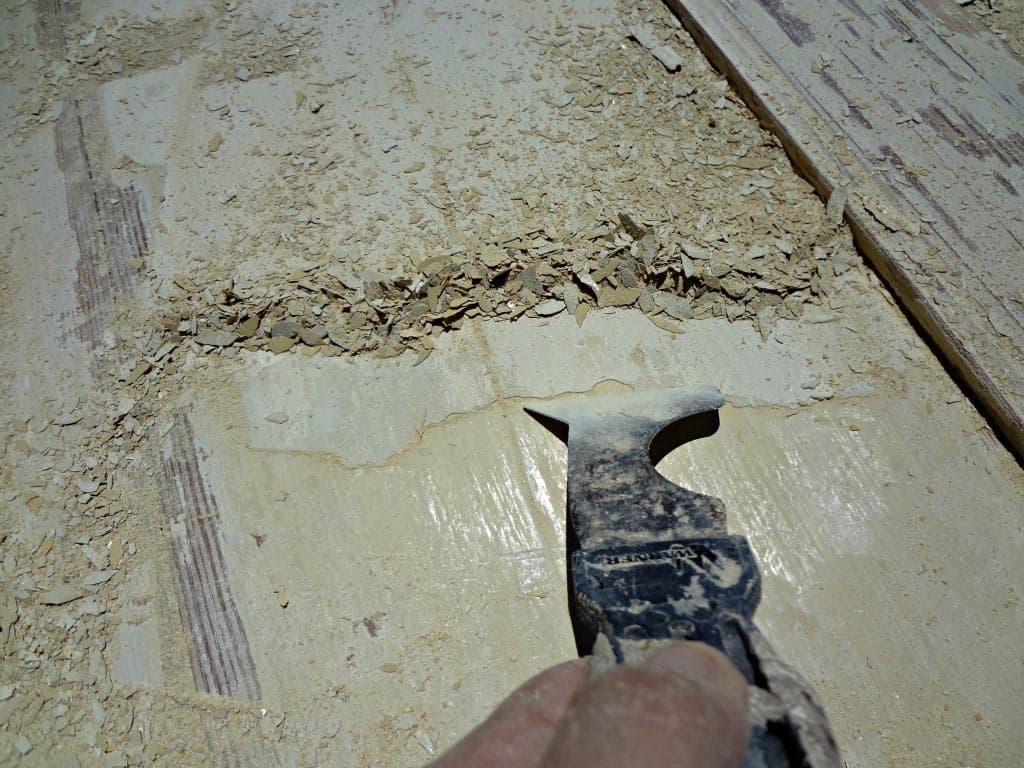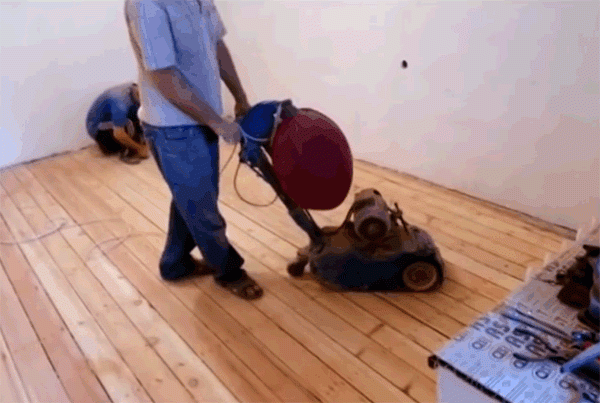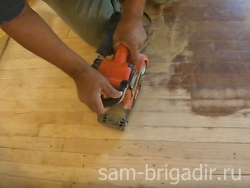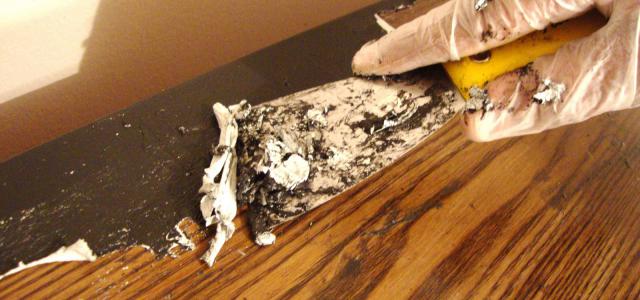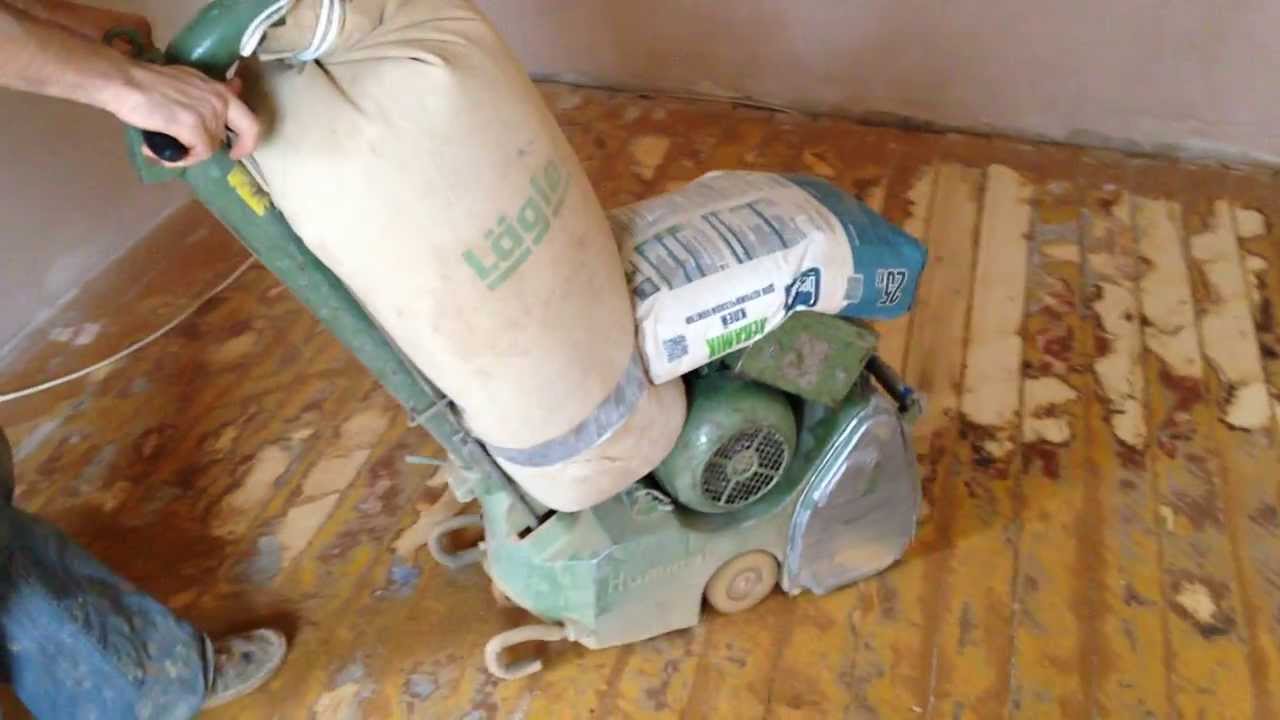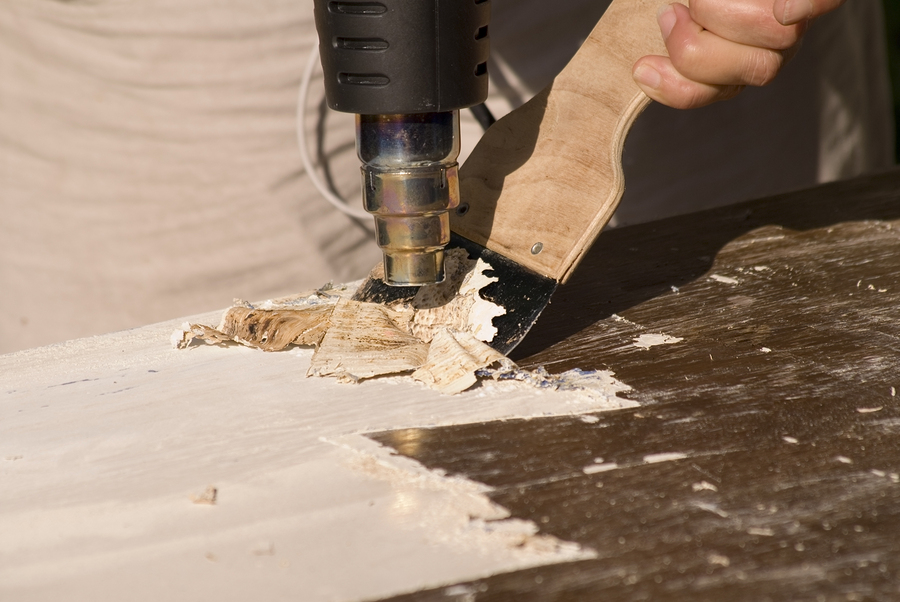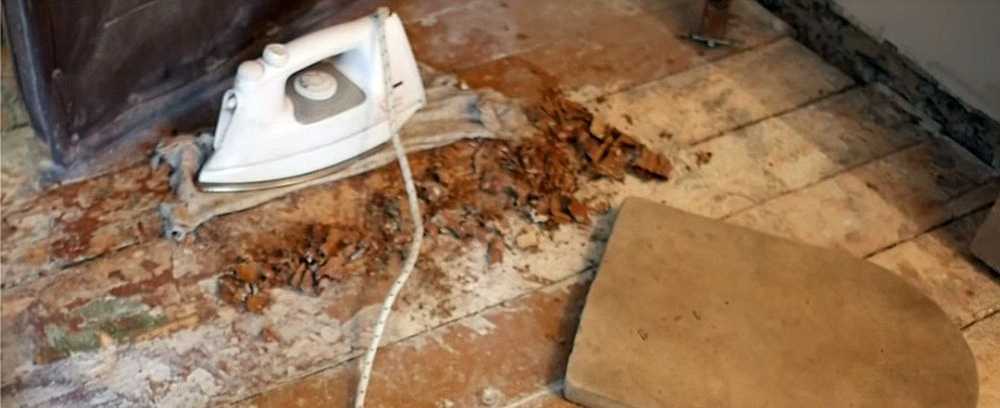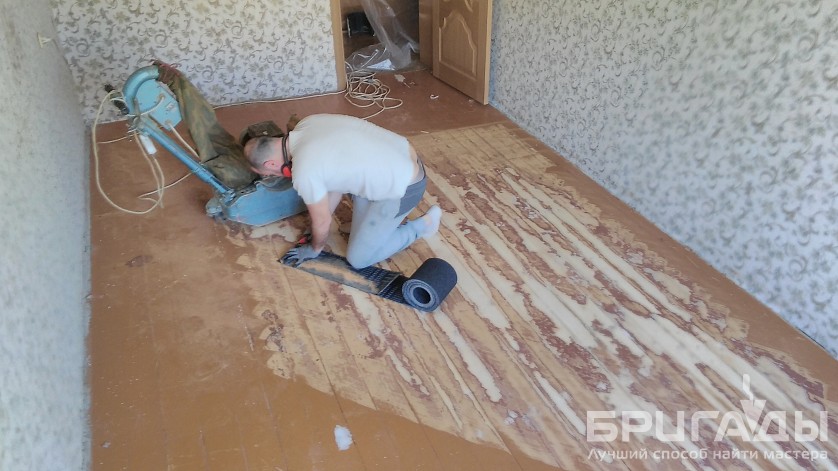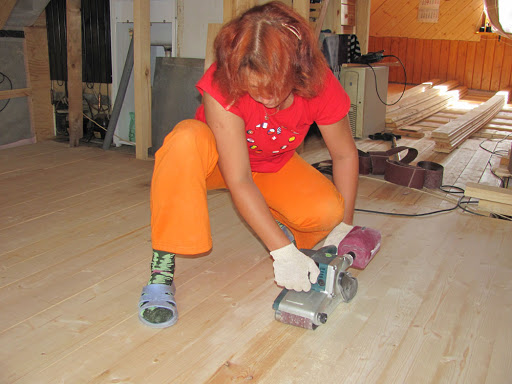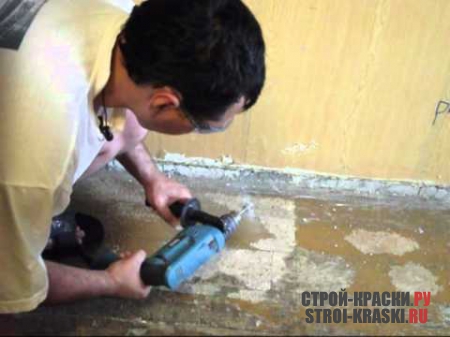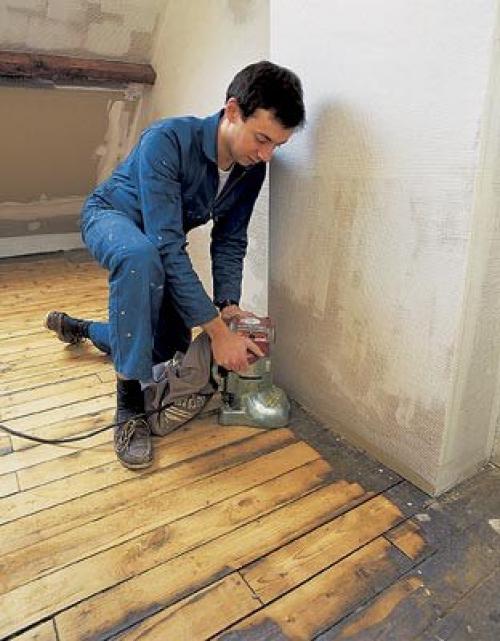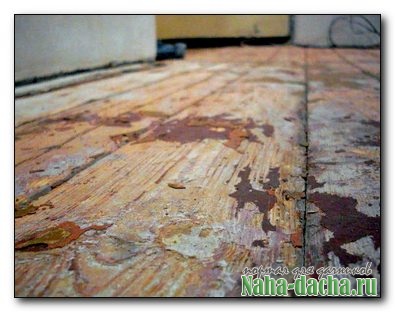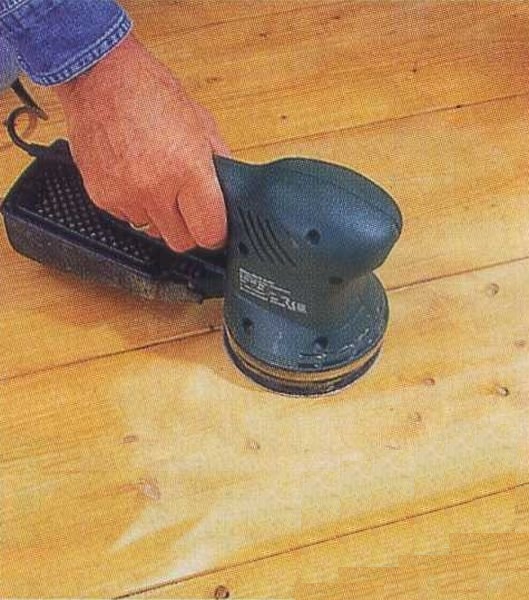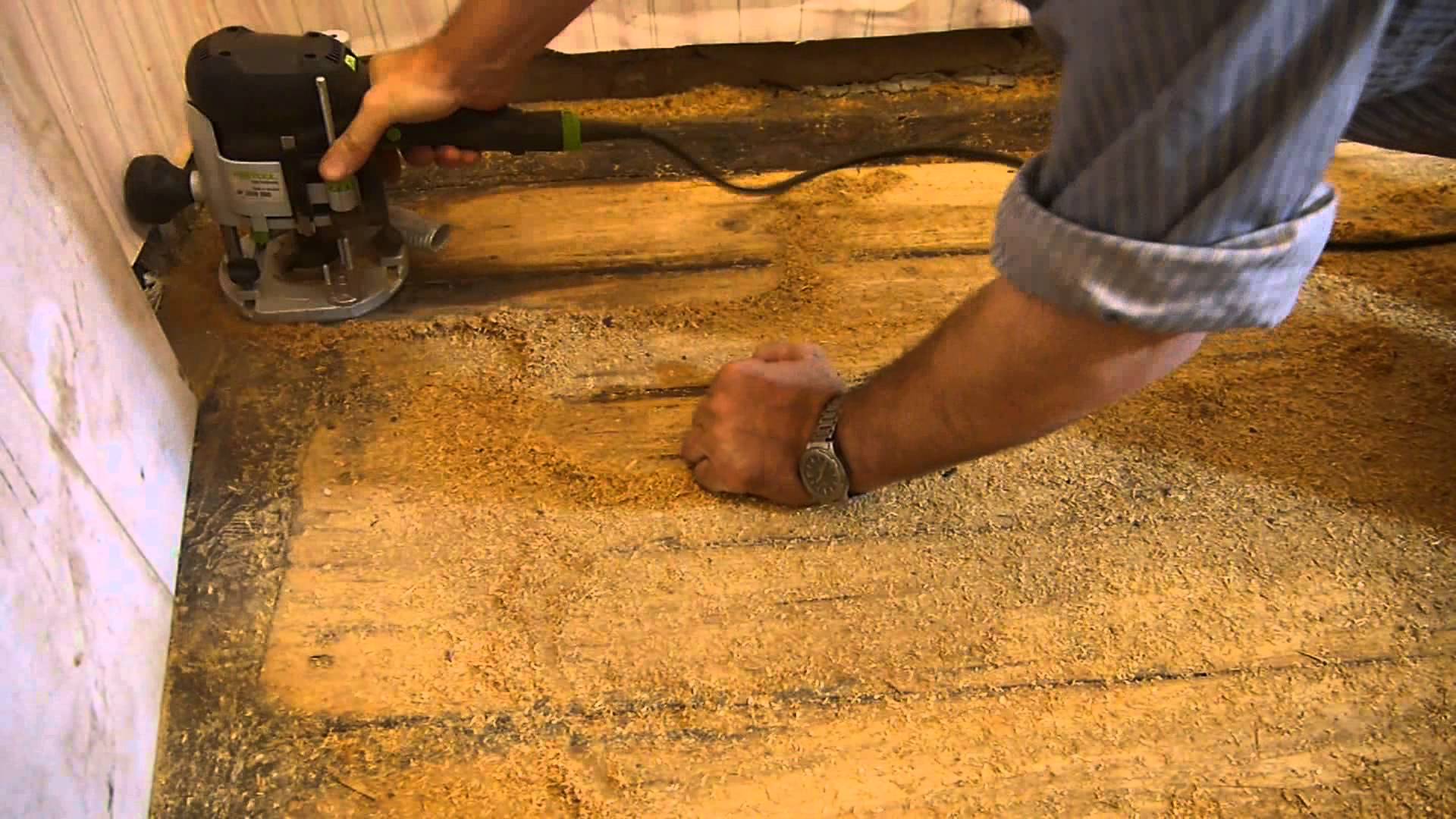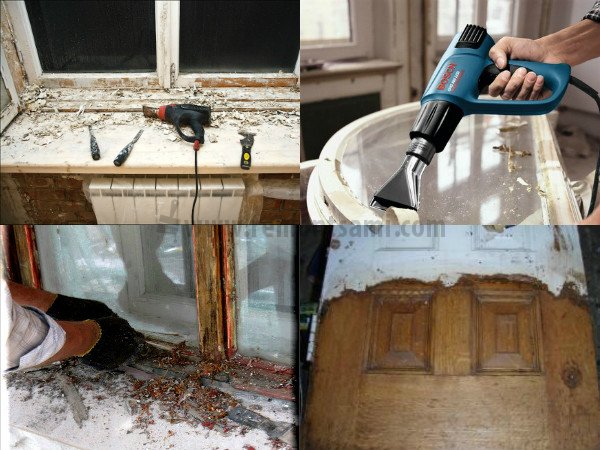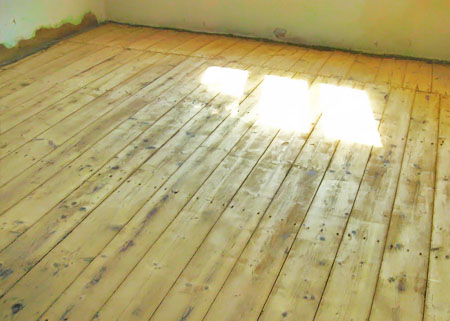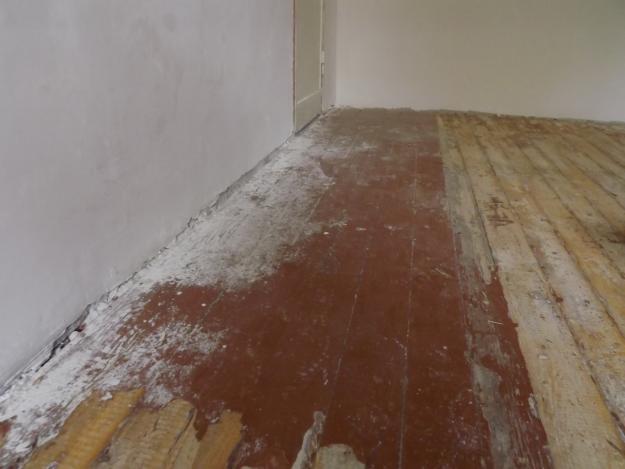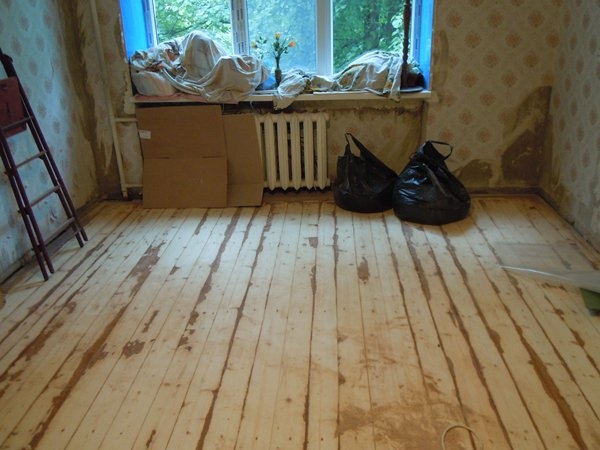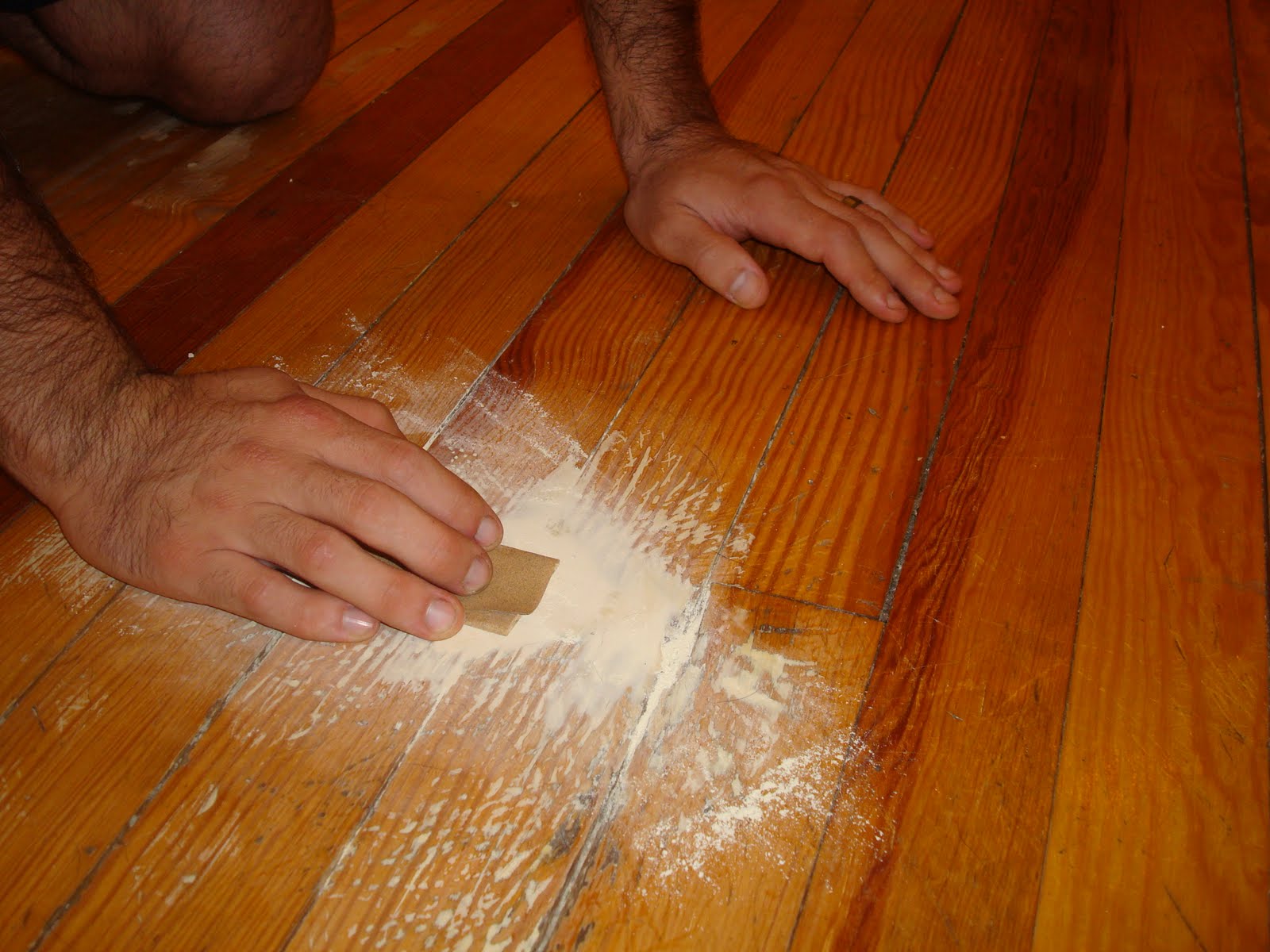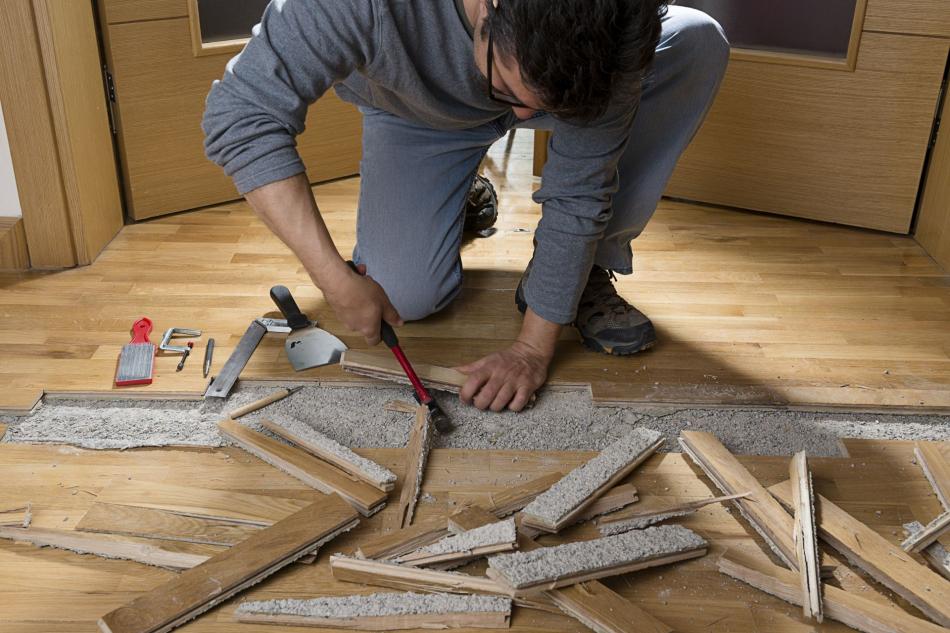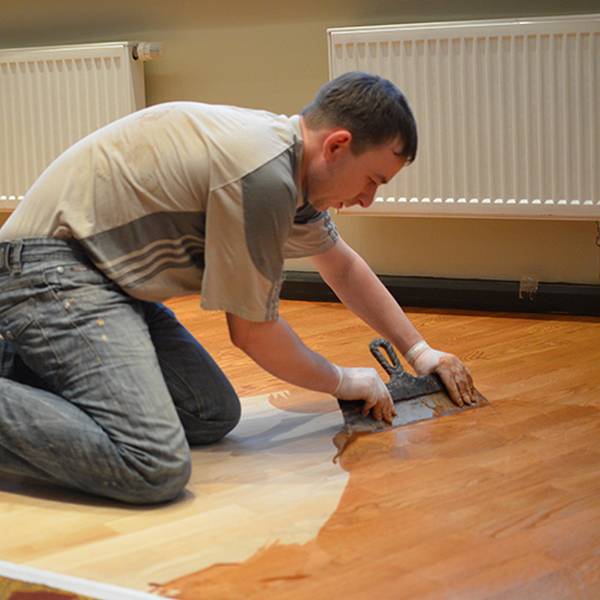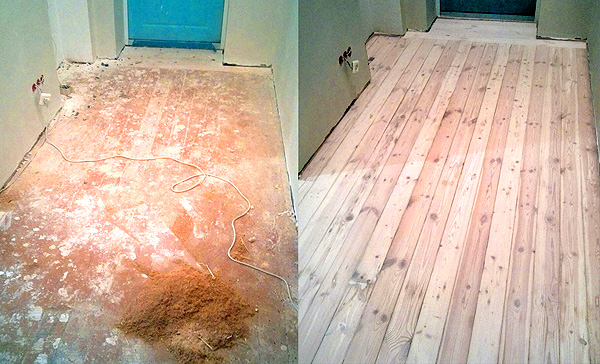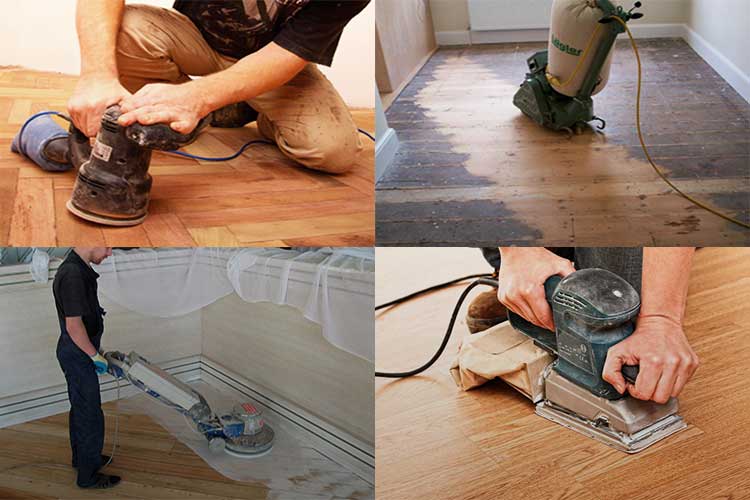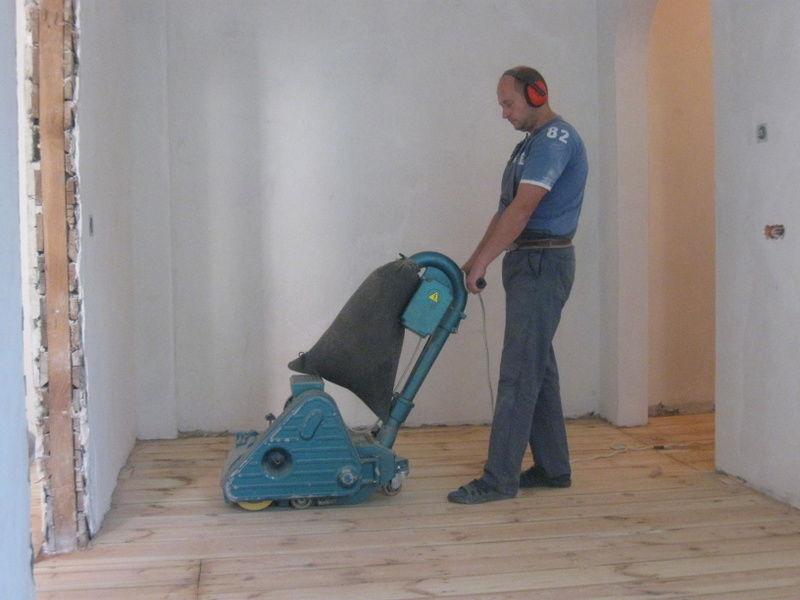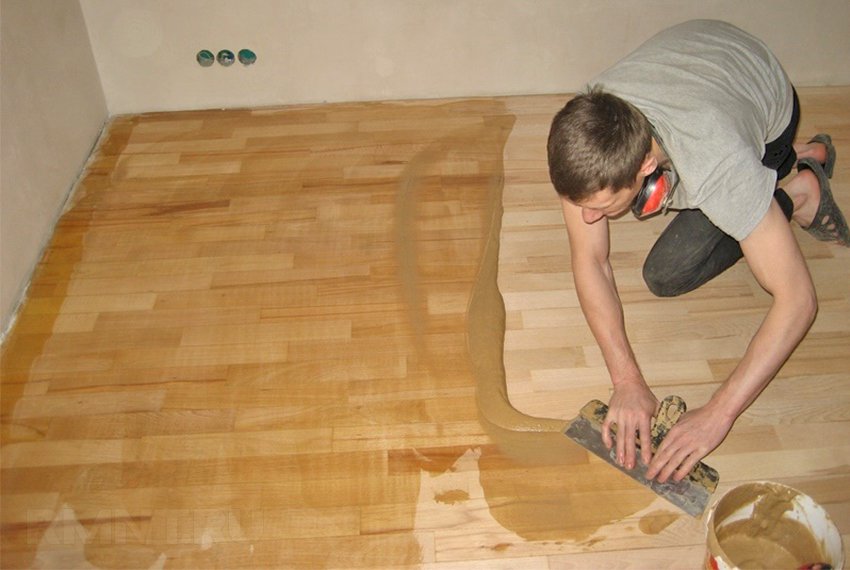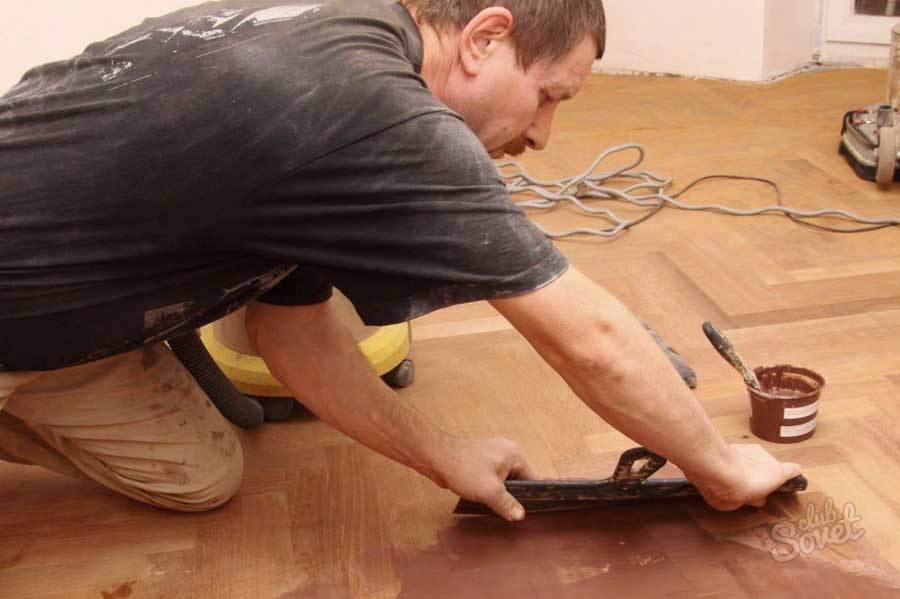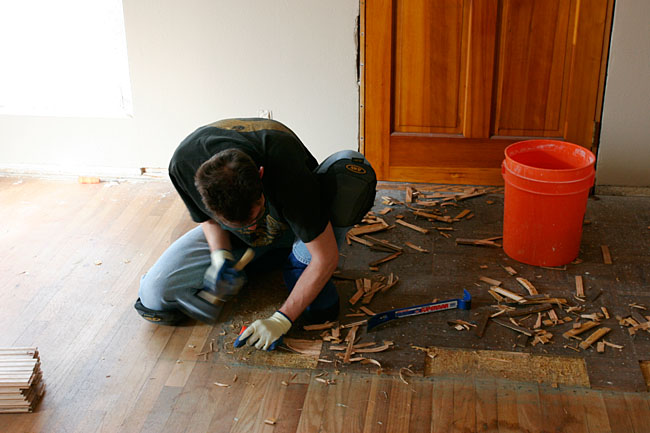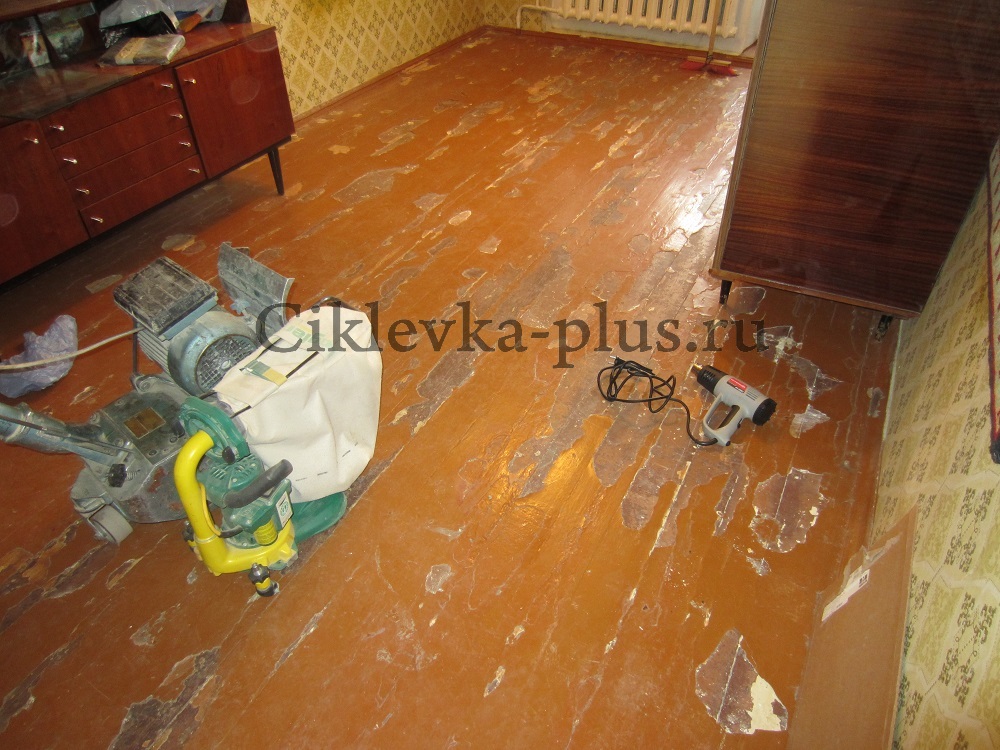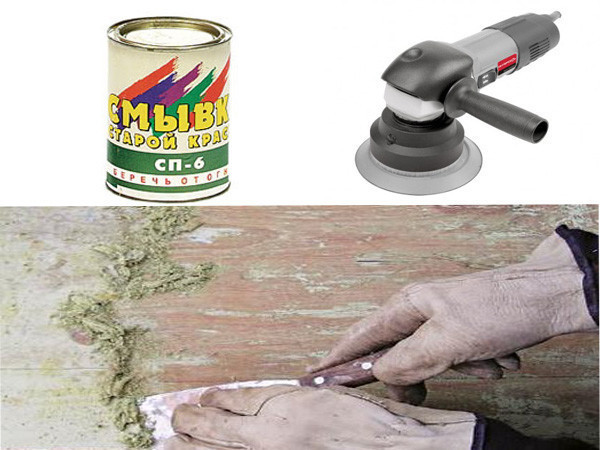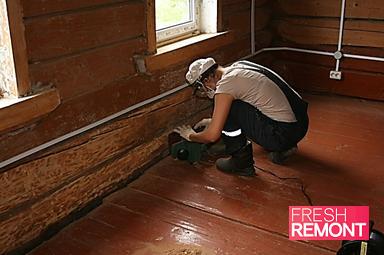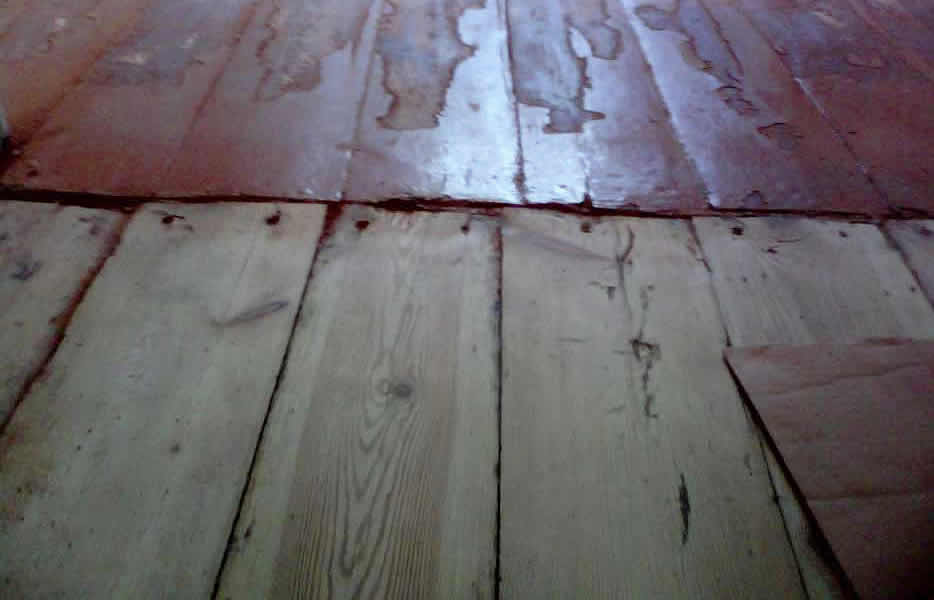Mechanical paint removal methods
The safest in terms of the absence of toxic substances and unpleasant odor is the mechanical removal option. You will need an additional tool that you can buy or rent.
Important: Take care of your own safety before any work. Put on your protective suit, goggles, respirator and gloves!
Spatula
The simplest and cheapest method is a spatula. With it, you can remove paint from walls, even in corners, around outlets and switches. The disadvantages include the complexity and duration of the work.
The blade is often used in combination with thermal or chemical treatment. That is, the coating is initially heated or dissolved, and then cleaned off.
It is convenient to use a sharp spatula-scraper, the advantages of which are described in the video:
Grinder
One of the fastest but most dangerous methods. If you do not have the skills to work with this tool, it is better to entrust the task to professionals or choose another method of paint removal.
The downside is the large amount of dust and noise that the neighbors will not like.
Professionals advise using not a stiff metal brush, but a diamond bowl - thanks to its strength and high rotation speed, you can quickly and easily remove even a thick layer of paint. You will learn how to choose and apply it from the video:
Stameskaya
The main advantage of a manual chisel is durability. If necessary, this tool can even withstand hammering without bending or deforming.
To clean paint off the walls this way:
- Sharpen the chisel (this step needs to be repeated periodically).
- Place to the wall at an angle of 60-80 degrees.
- Tap on it, leaving gaps of 3-5 mm.
- Scrape off any residue with a chisel or spatula.

With an ax
For this method, choose a light and convenient tool, because you won't be able to work with a heavy ax all day.
The idea lies in the same notches as when working with a chisel. But here you only need an ax.
Keep it at right angles and hit the wall 3-5mm apart.
Important: The paint will fly off, so protective goggles will come in handy.
Drill with different attachments
Many craftsmen consider this method to be optimal, because there is a drill in almost every home, it is lighter than a punch and safer than a grinder. Moreover, the process will take place much faster than when working with a hand tool.
As with the grinder, the iron brush is not the most reliable option. It is much faster and easier to remove the composition from the wall using several fixed chains. Such a nozzle is not difficult to make on your own, while its cost will be minimal. But you need to work with such a structure at low speeds and away from furniture or plumbing.
In the video, you will see the method in action:
How to remove paint from a concrete floor
The concrete floor is not always covered with other materials, as it is: painted, decorated in various ways, and can be cleaned of paint if desired. Most often, special washes and solvents are used to clean the concrete floor. Detergents cannot be simply poured onto the canvas, as not only instructions are required, but also safety precautions.
First you need to soak the coating with water for a day. Further, the concrete must be wiped with aggressive detergents so that the paint acquires porosity, and then a flushing solvent must be applied. The wash will gradually soften the paint, making removal much faster and easier. The paint and solvent gruel is removed with a scraper or stiff brush.The method is only suitable for fresh paint, since with the old dye, heavier artillery and other methods are needed.

Paint well peels off concrete with a grinder with a wide nozzle
It is quite possible to clean the concrete floor with a building hair dryer, and this is much easier to do than using a solvent or detergent. That is why the method is in great demand among many craftsmen. It can be used for any type of paintwork, including epoxy resins and waterproof varnish, but it will take a lot of time, patience and effort.
The withdrawal process takes place in stages:
- The painted concrete is exposed to a jet of hot air.
- Through contact with heat, the paint begins to boil.
- Next, you can remove the coating with a spatula or scrapers.
- It is advisable to carry out partial cleaning, since the paint, after swelling, may adhere again, or in other words dry out.
- Removal is not very fast, but very effective.
Methods for removing paint from wood
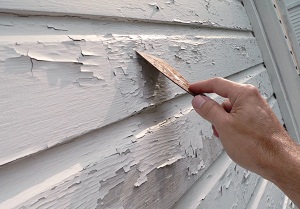
There are several ways to remove the old paint from the wood surface. The most common:
- chemical;
- thermal;
- mechanical.
Chemicals
You can remove old paint using chemicals that are sold in hardware stores. They contain emollient ingredients, thanks to which old paint can be easily removed from wood using a spatula. As a rule, they are applied to the wood with a roller or brush, left for a certain time to act (20-40 minutes). After that, the softened layer is removed with a spatula. If necessary, the procedure can be repeated.
When buying, you need to consider that the product is suitable for a specific type of material and paint. If there is a need to leave the room after processing the wood for a while, you can take a solvent-based composition. If this is not possible, it is better to take an odorless gel remover. But even the absence of a smell does not guarantee the absence of toxicity of the product. Therefore, work should always be carried out in protective equipment, and the room should be well ventilated.
Scheme for removing paint from wood by chemical means:
- Spread the composition evenly over the wood surface with a brush or roller.
- Leave it to work for a while.
- Rub the surface until the paint starts to peel off.
- Sand the wood from the remnants of old paint.
You can make your own caustic soda and oatmeal paste to remove the paint. Dissolve soda in water. Add oatmeal to it and stir. The mass should be similar in consistency to toothpaste. This tool works well for removing thick layers of old paint.
Important! Before applying chemicals, it is necessary to isolate other surfaces from their possible effects, in order to avoid damage.
Thermal method
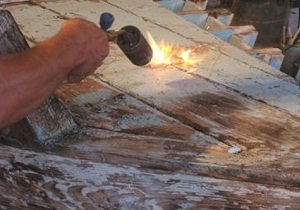
You can remove old paint from wood using a high temperature. When exposed to temperature, the paint begins to ignite, is taken by bubbles, and is separated from the surface of the tree.
For work, you need to take an iron or a hair dryer. Apply foil to the surface of the wood, warm it up with an iron or hairdryer, and remove any loose paint.
It is not recommended to use the hairdryer near plastic products and electrical wiring. Exposure to temperature can damage them.
Mechanical method
This method is effective over large areas. For mechanical removal of old paint, a grinder is often used with a special round nozzle with sandpaper or other abrasive. The paint is removed from the wood dry. This produces a large amount of dust. Therefore, work requires the use of protective equipment (gloves, respirator, glasses).It is advisable to use a fine-grained abrasive or sandpaper so as not to cause large scratches on the wood.
Safety engineering
Removing paint from the floor is not too difficult, but nevertheless, when carrying out this work, certain rules must be observed:
The use of heating devices is required with extreme caution, avoiding burning and inhaling the vapors generated during the heating of varnish and paint, while wearing a respirator. In addition to the latter, when using any of the methods, it is necessary to use other personal protective equipment that will exclude damage from vapors and dust not only to the respiratory tract, but also to the skin of the hands, wearing rubber gloves and glasses for this, which will provide eye protection.
Be sure to follow the instructions for use of chemical compounds and tools.
Before processing with the chosen method of flooring, you must first test it on an insignificant and less noticeable area, since in some situations any of the methods may be ineffective or ineffective .. If all these recommendations are followed, many negative consequences can be avoided
If all these recommendations are followed, many negative consequences can be avoided.
Repair of an old wooden floor in a house: options and features
In a private house, there may be all the same problems with a wooden floor - creaking, failures. If repairs are needed for the floor of the second floor, and it was done along the beams, you can only level it and paint or varnish it again. With or without bulkhead boards - this is your choice. But other problems, besides irregularities and cracks, usually do not happen here.
How should it be arranged
If the renovation of the old wooden floor in the house is on the ground floor, then everything is more complicated. We still need to see if the steam, hydro, thermal insulation is done correctly.
 Floor arrangement on the first floor of the house - with insulation and vapor barrier
Floor arrangement on the first floor of the house - with insulation and vapor barrier
The correct design meets the following conditions: it is protected from moisture penetration from the side of the room, but does not interfere with the removal of moisture from the insulation. Therefore, from the side of the room, vapor-waterproofing is laid. It does not allow steam or liquid water to pass through. But no matter how you protect, some moisture will still get inside. And it must be removed. It will be displayed from the basement / subfloor side. Therefore, on this side, a material is needed that does not interfere with the passage of water and vapors. You can only fix the insulation. For this:
- knock out with slats;
- tighten with a wire in the form of a snake;
- metal mesh.
But this option, when using mineral wool as a heater, is not very good. To remove moisture, the subfloor must be ventilated. This means that there are drafts walking around there. And they, along with moisture, carry away the heat. A lot of warmth. The insulation itself also erodes. But he (insulation) remains dry. The situation can be improved by hemming the windproof membrane from below. But it must be vapor-permeable. So that the moisture that gets inside the insulation is removed.
What could be
If, when checking the floor structure, you find that the boards, logs, beams, insulation are wet, then something was done wrong. In this case, there is usually a problem with the wood. There is nothing to say about insulation. If it is mineral wool, it practically does not perform its functions under such conditions. After a couple of years (or even several months) it turns into dust. Not because the material is bad, but because it was used in conditions for which it was not intended.
 If the picture is something like this, the structure will be replaced.
If the picture is something like this, the structure will be replaced.
If this is the case, and there is a lot of moisture, the wood has rotted, the repair of the old floor is only a complete replacement of the structure with correction of errors. The most common mistake is using waterproofing material from the basement side.In this case, moisture may even accumulate on the film. It flows down to the lowest places, the film sags. It is necessary to disassemble the floor from below, leave it without insulation to dry the boards for several weeks. Then assess the condition of the wood. If everything is fine, restore the insulation, but without errors.
If the floor is earthen in the subfield, moisture will rise from the ground. To prevent it from “wetting” the insulation from below, cover the subfloor with a thick film (at least 350 g / m2). Lift the film to the foundation, fix it there with planks. Pour and level a layer of sand on the film. The film will prevent the penetration of moisture from the soil, sand will adsorb what gets in or what falls in the form of moisture condensed from the insulation. In some regions, sand is expensive, bark, forest soil, dry foliage, even sifted soil, but only one that normally absorbs moisture can be used. In any case, the backfill should be free of knots, branches, stones. They can damage the film.
Remove old paint using a construction hair dryer (heat, heat treatment)
There is another preparation method for oil paint removal by heating the surface with a construction hairdryer. The construction hair dryer itself is similar to the usual hair dryer for drying hair, but it has increased power. The cost of such a hair dryer is not high, but it can be useful for other purposes as well. By the way, those who have a fireplace in the house, it is simply necessary.
The principle of work for removing old paint with a building hair dryer is simple.It is based on the fact that an increase in temperature reduces the adhesion of the paintwork and the painted surface. Simply put, the paint softens and is easily removed from the surface with a spatula.
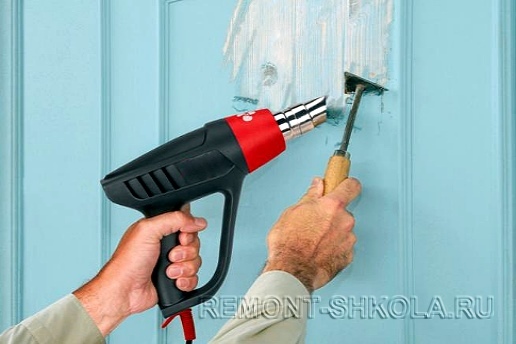
Working with a blow dryer is slower but much safer than using a gas burner.
Working with a hair dryer is a rather laborious process, since the hair dryer heats the surface to be cleaned locally and the cleaning process does not progress so quickly.
Heat treatment when removing oil paints is ideal for wood surfaces. Work on concrete surfaces is worse. Even worse on metal (the thicker the metal, the worse).
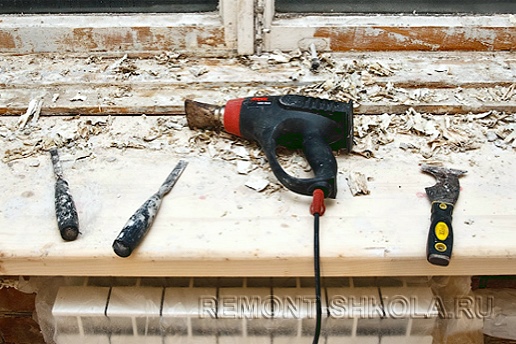
Heat treatment of the surface to be cleaned allows the work to be carried out in a shorter time.
As in the case of surface preparation with chemical compounds, it is necessary to provide fresh air in the room during thermal preparation. This is forced draft, or ventilation. Personal protective equipment is required.
Work carefully near flammable objects, plastic, plastic, glass.
In addition to the construction hair dryer, it is possible to use thermal preparation of the painted surface for cleaning using a gas burner. It can be either manual or professional roofing, depending on the work area. But this preparation method is not recommended, as it is fire hazardous.
Regardless of the decision you made on how to clean the surface from old oil paint, follow the safety measures.
Use of chemistry
The composition is used as follows:
- All doors and windows are opened. Air must constantly flow into the room.
- All surfaces that cannot be processed are covered with plastic wrap. Liquid spills on furniture or floors will cause stains.
- Pour the product into a separate container. A brush or roller is immersed in the composition. The tool is selected taking into account the consistency of the wash. The roller is rolled over a perforated tray.
- Apply the solvent to the base to be treated. Wait until the dye composition dissolves. The procedure takes 10-30 minutes.
- Remove the dissolved material with a metal tool. If necessary, the liquid is reapplied.
When choosing a wash, the following points are taken into account:
- Gel formulations are more expensive than liquid formulations. However, the thicker consistency provides faster results.
- When working in a room with poor ventilation, use the least aggressive formulations. Working with them takes a lot of time, but the likelihood of poisoning is excluded.
- It is not recommended to use inexpensive solvents of domestic production. A multi-layer oil coating cannot be removed with such a wash. Means of foreign production quickly cope with the task.
- Some washes tend to darken the substrate to be treated. If it is impossible to refuse to use them, the tree is bleached with chlorine.
You can remove old paint with caustic soda. The substance is dissolved in a small amount of water to the consistency of thick sour cream. Ground oatmeal is added to the mixture. The resulting paste is spread over the surface. When the paint swells, it is scraped off with a spatula. Before further processing, the base is degreased.
Thermal method
This method consists in thermal effect on the painted surface. Due to heating, the paint and varnish composition becomes soft and viscous, after which it can be easily removed with a spatula or other hand tool. To heat the painted floor, you can use a hair dryer, a burner, and some even use an iron that heats the paint through foil.
The thermal method allows you to remove even very old paintwork from wood. As a result of heating, the coating begins to bubble, and is removed almost effortlessly with an ordinary spatula. An important advantage of this method is the ability to apply new paint immediately after removing the old composition, since there is no need to wait until the floor is dry. In addition, no other special training is required.
Although this method is very simple and convenient, it has some disadvantages and dangers. For example, care must be taken not to create a fire hazard, as a result of strong heating, paint and wood can ignite
Another danger is that when heated, many paints and varnishes release into the air harmful to humans, even hazardous substances, so it is important to work in a well-ventilated area and wearing a respirator. If the old coloring composition is overheated and is not removed from the floor in time, it may bake, and subsequently it will be almost impossible to remove it.
How to remove paint from the floor
The first step is to prepare personal protective equipment and tools. Remove all objects and furniture from the room, so they will not interfere, and you will not have to remove dust from them. If the boards are nailed, then it is better not to use a sander and electric planer, because they can break.
In order to remove the coating as effectively as possible, it is important to determine which paint was applied. For floors, use a water-based, acrylic or oil mixture.
The oil composition is most difficult to remove; thermal and mechanical methods are used in combination with each other to remove it. Fresh acrylic paint can be removed with an alcohol solution or water, but if it has been applied a long time ago, a mechanical or thermal method will be required. Water-based dyes are afraid of water, so the floors are abundantly moistened, after which they are effortlessly cleaned.
If you have a hair dryer, you can quickly get rid of the old dye with it and using a spatula. This thermomechanical method is as follows: in one hand there is a switched on hairdryer, which heats the surface, and in the other hand there is a spatula, which immediately removes the softened layer. Usually the paint is removed in large layers.
If a chemical wash is used, be sure to follow the instructions. This preparation is applied to the floors with a brush, and after 10-60 minutes, when the coating softens, swells and becomes covered with bubbles, it can be easily removed with a metal spatula.
So, there are several methods to remove old paint and varnish compositions.If one method does not work, you can use another.
Methods for removing old paint
There are three methods - mechanical, heat treatment and chemical washes.
Heat treatment
The process involves heating the old coat of paint to the point that it snaps off from the substrate. Experienced craftsmen burn the surface with an open burner, but it is better to use a special hairdryer or heater on the platform.

A jet of hot air is supplied locally, the decorative layer swells, lags behind the base. After this treatment, the paint can be easily removed with a spatula or scraper.
The platform with the heater looks like an ordinary iron. It is not difficult to work with the tool, but the wood should be heated through the foil, otherwise the base will burn. In the process of heating, the paint will become soft, swollen, like when working with a hairdryer. The only advantage of working with the platform is efficiency. You can immediately warm up a significant area.
If the paint has strongly eaten into the wood, you cannot do without a blowtorch
But here it is important not to overheat the processing area so that the tree does not char.
Mechanical cleaning
A laborious option, but extremely effective. How to clean:
- hand tools - emery, spatula, scrapers;
- electrical appliances - a drill with a nozzle, grinders, etc.
Loading …
Expert opinion
Vladislav Ponomarev
Design engineer, inventor
When restoring old doors, floors made of expensive varieties of wood, only manual labor is used.
It is permissible to warm up the areas with a hairdryer, then carefully remove the paint with a scraper. Cleaning is performed only with emery of different fractions.
Chemical treatment
Ready-made washes in stores are presented in the widest range. There are compositions for different types of paints. The washes should be applied strictly according to the instructions - soak the coating, wait for the paint to soften, remove the layer. After washing off the decor, it is recommended to treat the surface of the tree with water or white spirit to remove the remnants of the remover.
Loading …
Folk remedies are no less effective:
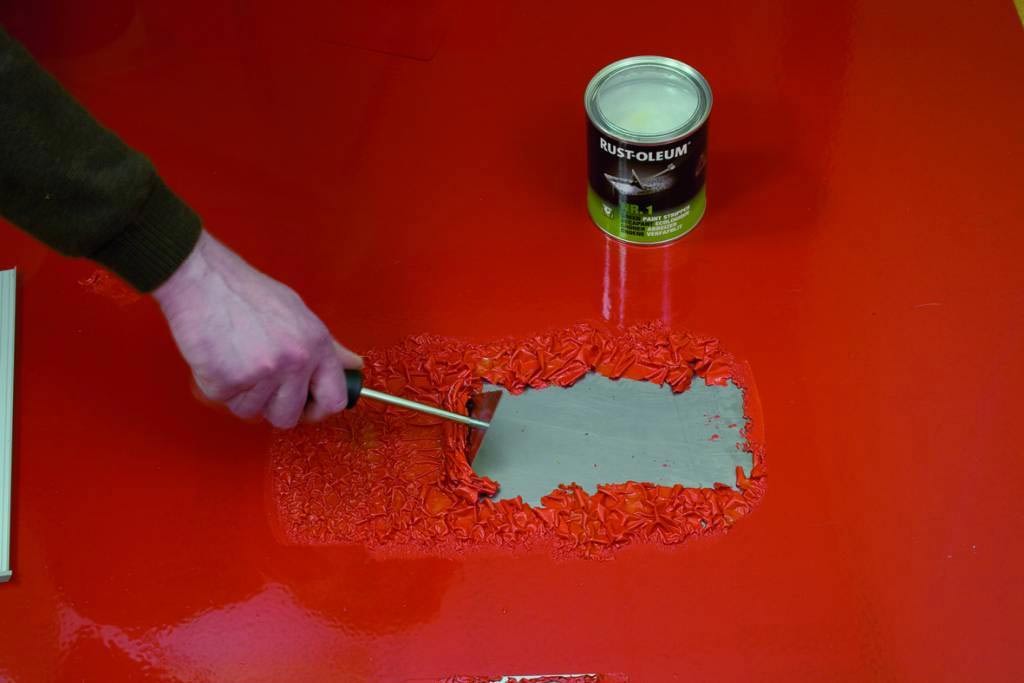
- Bleaching powder. Dissolve quicklime bleach in water, soak the painted surface abundantly with liquid. As the chlorine evaporates, the paint will begin to lag behind and lend itself to cleaning with a spatula or washcloth.
- Caustic soda. A cheap product that is safe for health. To make a wash, you need to dilute the soda with water (1: 5), add oatmeal so much that the mixture resembles a liquid paste in consistency. Apply the substance to the painted surface, leave for 10-12 hours. After processing, the paint leaves almost by itself.
Why remove old paintwork
Floor painting is one of the most popular types of finishes, as paint provides a decent appearance and protection from external influences. It is widely used for wooden surfaces, since they suffer most from high humidity, are susceptible to fading in the sun and are often irreparably damaged by pests.
Before you paint the floor with new paint, you need to clean the existing one. Sometimes it is possible to paint directly on top of the old coating, but there is a risk of forming a layer that is too thick, which can interfere with the free opening and closing of doors. In addition, cracks often appear on the paint, and if the coating is not removed, they will appear on a fresh surface.

Before removing old paint, it is important to understand what material the floor is made of. The cleaning method directly depends on this:
- Wooden floor. Usually, it is not difficult to remove the decorative coating from such a surface, but one nuance must be taken into account. Often, floorboards are attached to the joists using ordinary nails, in which case it is better to refuse to use some tools.Devices such as an electric plane or sander can simply break if they bump into a nail.
- Self-leveling floors. It is easiest to clean them of paint - absolutely any tool is perfect for this. It happens that when pouring on the surface, irregularities are formed, but it is easy to remove the coating from them manually, unless it takes a little longer.
- It is better to clean ceramic tiles and linoleum with a building hair dryer, as any other method increases the risk of damage to both the surfaces themselves and the tools used.
Recommendations: how to remove paint from parquet
Parquet flooring: chic, expensive and beautiful. What to do if the parquet has been painted or accidentally stained with paint? It is worth using mechanical processing, for which you need to use a special tool, both manual and electric. An electric tool is considered to be the most suitable, as there is an option to achieve excellent success by doing a DIY floor cleaning.
It does not take too much effort to process even an area that is too large. Hand tools are used in cases where you need to clean up a hard-to-reach place and work in a limited area, or remove paint that has begun to peel off and swell.
These tools include:
- Scraper;
- Sandpaper;
- Brush;
- Putty knife.
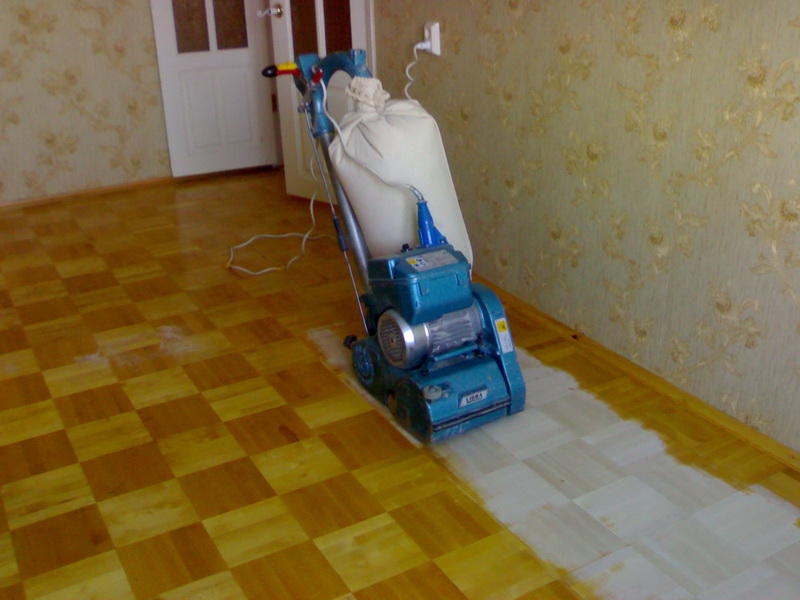
Professionals use special surface grinding machines, due to which it is possible to clean the floor of a large area of paint
If we talk about an electric tool, then it is permissible to use a grinder or grinder with a special attachment. Some experts use a drill with a specific attachment in the form of a metal brush.
Under high pressure, it is possible to remove not only the old paint from the parquet, but also the rust from the metal surface. Among the advantages, it can be noted that it is not required to carry out additional preparation of the floor before processing. Also, this method allows you to clean hard-to-reach places in a minimum amount of time and without much effort. The mechanical method is used when complete removal of paint and varnish coatings is not required, but partial processing of the canvas is required.
Deprecated removal methods
Some craftsmen in their work use a thermal method of removing the old coating by exposing the treated area of the product to open fire. It is highly discouraged to use this method due to the increased danger of a possible fire.

Removing old paint with open fire is unsafe
In addition, when processing products from various types of wood using this method, the material dries out and its internal structure is disturbed, which significantly reduces the strength of the product and its service life.
Some types of wood during this treatment can release resins that are highly flammable or create a film on the product. This film will significantly reduce adhesion, or may not at all provide an opportunity to apply a new layer to the surface.
When choosing methods for removing the old coating, the main thing is to follow the rules of personal safety, use protective equipment and observe safety precautions when working with electrical appliances.
Chemical method
Manufacturers today offer a variety of chemical compositions that allow you to remove old paintwork from the floor. Such preparations can be made from different acids, solvents and alkalis. They are very easy to use, they are applied to the painted wood and after a while they are removed along with the softened paint. After that, the surface is washed with plain water. Usually, after the chemical has softened the paint and varnish composition, it is removed with a cycle or a spatula.
One of the significant advantages of the chemical method for removing dyes is ease and simplicity, no physical effort is required. And the disadvantage of this method is financial costs, since chemicals are not cheap, so they are most often purchased for treating small surfaces. Another disadvantage of this method is insufficient efficiency in relation to dyes applied many years ago. If the paint is very old, it will most likely need to be reworked twice or thrice.
It is not necessary to purchase a special chemical remover; you can use available liquids. For example, mineral kerosene helps to remove many types of dyes from the surface of a tree. If the paint is water-based, plain warm water will help wash it off. Organic solvents such as White Spirit help to soften paints made with similar solvents.
You can mix soda ash with lime, this mixture allows you to remove old paint layers. To do this, you need to mix quicklime with soda in a ratio of three to one, the result should be a creamy mass. This compound is applied to the painted wood, and after 12 hours it is cleaned with a spatula or scraper. It is enough even to pour water on the floor, and then pour abundantly soda ash over the entire surface. The old stain will rise and be removed with little effort with a spatula.

